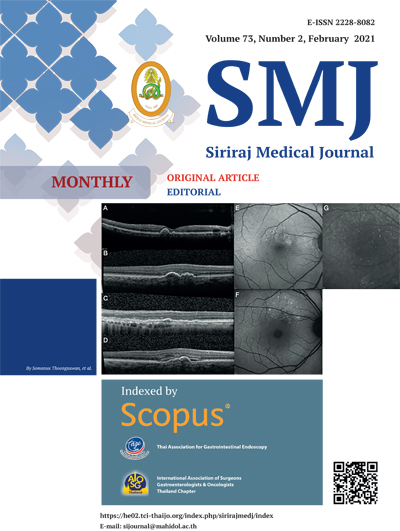Sudden Sensorineural Hearing Loss among COVID-19 Patients-Our Experiences at an Indian Teaching Hospital
DOI:
https://doi.org/10.33192/Smj.2021.11Keywords:
COVID-19 patients, SARS-CoV-2, sudden sensorineural hearing lossAbstract
Objective: Sensorineural hearing loss is a known complication of several viral infections. The association between the SARS-CoV-2 and sudden sensorineural hearing loss (SSNHL) is making a challenge to the clinician in current COVID-19 pandemic. The objective of this study is to study the incidence of the sudden sensorineural hearing loss (SSNHL) in patients with COVID-19 infections.
Methods: This is a retrospective descriptive study. There were 16 COVID-19 patients participated in this study those presented with sudden sensorineural hearing loss (SSNHL). The study was done between March 2020 to August 2020. All these patients were diagnosed of SARS-CoV-2 infection with help of the reverse transcription polymerase chain reaction (RT-PCR) testing.
Results: Out of 16 patients with SSNHL, 11 (68.75%) were male and 5(31.25%) were female with male to female ration of 2.2:1. The age ranges of the participants were 38 to 72 years with mean age of 48.42 years. Out of the 16 patients with SSNH, 14(87.50%) were presented with unilateral and 2(12.50%) were presented with bilateral SSNHL. There were left sided SSNHL in 9 patients (56.25%) and right side SSNHL in 5 patients (31.25%). Out of the 16 patients of SSNHL, 3(18.75%) were completely asymptomatic except hearing loss and rests were presented with different clinical manifestations of the COVID-19 infections. Out of 16 patients 9(56.25%) were recovered with appropriate and prompt treatment.
Conclusion: There should be a continuous monitoring of the SSNHL. Tracing of COVID-19 infection is needed to ensure the detail understanding of this inner ear pathogenesis.
References
2. Wang W, Tang J, Wei F. Updated understanding of the outbreak of 2019 novel coronavirus (2019-nCoV) in Wuhan, China. J Med Virol 2020; 92(4):441-47.
3.Swain SK, Das A, Sahu MC, Das R. Neonatal hearing screening:Our experiences at a tertiary care teaching hospital of eastern India.Pediatric Polska 2017;92(6):711-5.
4.Leung AK, Hon KL, Leong KF,Sergi CM. Measles:a disease often forgotten but not gone.Hong Kong Med J 2018;24(5):512-20.
5. Weiss D, Böcker AJ, Koopmann M, Savvas E, Borowski M, Rudack C. Predictors of hearing recovery in patients with severe sudden sensorineural hearing loss. J Otolaryngol Head Neck Surg 2017;46:27.
6. de Wilde AH,Snijder EJ, Kikkert M,vanHemert MJ. Host factors in corona virus replication. Curr Top Microbiol Immunol 2018; 419:1-42.
7.Swain SK,Das S,Padhy RN.Performing tracheostomy in intensive care unit-A challenge during COVID-19 pandemic 2020;72(5):436-42.
8.Wu A, Mc Googan JM. Characteristics of and important lessons from the corona virus disease 2019(COVID-19) outbreak in China: summery of a report 72314 cases from Chinese Center for Disease Control and Prevention. JAMA 2020.
9.Corona virus disease 2019(COVID-19) situation report-66.World Health Organization.March 26,2020 https://www.who.int/docs/defaultsource/coronavirus/situation-reports/20200326-sitrep-66-covid-19.
10.World Health Organization.Corona virus disease(COVID-19):weekly epidemiological,update 1.2020.
11.Cao Zhong-Si Hong, Tan Yuan-Yang, Chen Shou-Deng, Jin Hong-Jun, Tan Kai-Sen, Wang De-Yun, et al. The origin, transmission and clinical therapies on coronavirus disease 2019 (COVID-19) outbreak – an update on the status. Mil Med Res 2020;7: 11.
12.Wilson WR. The relationship of the herpesvirus family to sudden hearing loss: a prospective clinical study and literature review. Laryngoscope 1989;96:870–7.
13. Esaki S, Goshima F, Kimura H, Ikeda S, Katsumi S, Kabaya K, et al. Auditory and vestibular defects induced by experimental labyrinthitis following herpes simplex virus in mice. Acta Otolaryngol 2011;131:684–91.
14.Cashman KA, Wilkinson ER, Zeng X, Cardile AP, Facemire PR, Bell TM, et al. Immune-mediated systemic vasculitis as the proposed cause of sudden-onset sensorineural hearing loss following lassa virus exposure in cynomolgus macaques. MBio 2018;9:1896–1918.
15. Mao L, Jin H, Wang M, Hu Y, Chen S, He Q, Chang J, Hong C, Zhou Y, Wang D, Miao X. Neurologic manifestations of hospitalized patients with coronavirus disease 2019 in Wuhan, China. JAMA neurology 2020;77(6):683-90.
16.Arabi YM, Balkhy HH, Hayden FG, Bouchama A, Luke T, Baillie JK, et al. Middle East respiratory syndrome. N Engl J Med 2017; 37:584–94.
17.Desforges M, Favreau DJ, Brison E, Desjardins J, Meessen-Pinard M, Jacomy H, et al. Human coronavirus: respiratory pathogens revisited as infectious neuro-invasive, neurotropic, and neurovirulent agents. CRC Press; 2013. p. 93–122.
18. National Health Commission of People's Republic of China. Diagnosis and treatment of the novel corona virus pneumonia (Trialversion7)[D].Published.2020 http://www.nhc.gov.cn/yzyg.j/s7653p/202003/46c9294a7dfe4cef80dc7f5912eb1989/files/ce3e6945832a438eaae415350a8ce964.pdf [Accessed 03 March 2020].
19. Cure E, Cumhur Cure M. Comment on “Organprotective effect of angiotensin-converting enzyme 2 and its effect on the prognosis of COVID-19.” J Med Virol 2020;10.1002/jmv.25848. doi:10.1002/jmv.25848.
20.Liu W, Li H. COVID-19: attacks the 1-beta chain of hemoglobin and captures the porphyrin to inhibit human heme metabolism. ChemRxiv 2020;10(04):1-23.
21.Krasniqi S, Daci A. Role of the angiotensin pathway and its target therapy in epilepsy management. Int J Mol Sci 2019;20:726.
22.Paludetti G, Ottaviani F, Fetoni AR, Zuppa AA, Tortorolo G. Transient evoked Otoacoustic emissions(TEOAEs) in newborns: normative data. Int J pediatr otorhinolaryngol 1999;47(3):235-241.
23.Hara JH, Zhang JA, Gandhi KR, Flaherty A, Barber W, Leung MA, et al. Oral and intratympanic steroid therapy for idiopathic sudden sensorineural hearing loss. Laryngoscope Investig Otolaryngol 2018; 3: 73–7.
24.World Health Organization. Clinical management of severe acute respiratory infection (SARI) when COVID-19 disease is suspected: interim guidance V 1.2.13 March 2020, WHO reference number: WHO/2019-nCoV/clinical/2020.4. 2020.
Published
How to Cite
Issue
Section
License
Copyright (c) 2021 Siriraj Medical Journal

This work is licensed under a Creative Commons Attribution-NonCommercial-NoDerivatives 4.0 International License.
Authors who publish with this journal agree to the following conditions:
Copyright Transfer
In submitting a manuscript, the authors acknowledge that the work will become the copyrighted property of Siriraj Medical Journal upon publication.
License
Articles are licensed under a Creative Commons Attribution-NonCommercial-NoDerivatives 4.0 International License (CC BY-NC-ND 4.0). This license allows for the sharing of the work for non-commercial purposes with proper attribution to the authors and the journal. However, it does not permit modifications or the creation of derivative works.
Sharing and Access
Authors are encouraged to share their article on their personal or institutional websites and through other non-commercial platforms. Doing so can increase readership and citations.














